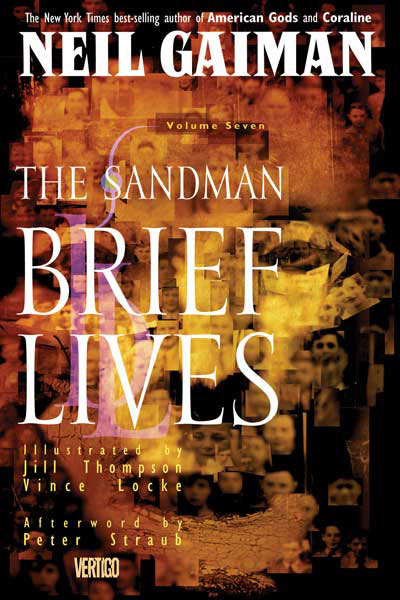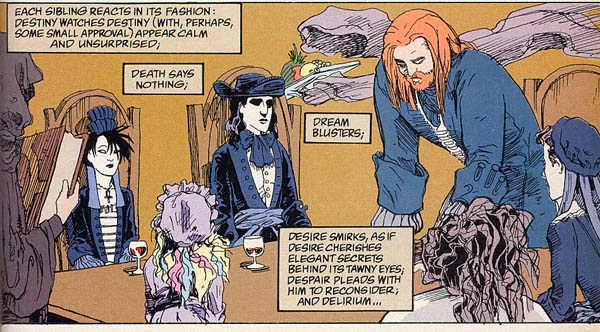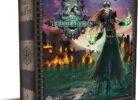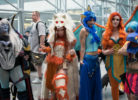Eight years ago, Stephen Segal, then creative director at the legendary Weird Tales magazine, asked if he could use some modest writings I had been doing on Neil Gaiman’s Sandman for a 20th anniversary retrospective he was putting together. Naturally, I said yes. Sadly, the series was lost in a website revamp. Not wanting it to disappear into the ether, I’m now presenting it on my site in 11 parts (alas, without the benefit of Stephen’s editing; these are pre-publication versions). Hope you enjoy.
Recurring Dream: An Anniversary Re-reading of Neil Gaiman’s Sandman
Part 8 of 11, Brief Lives
Originally published on the Weird Tales website, January 2009
 With all the gods and demons and twisted mythology of Sandman, it’s easy to forget how warm and inviting Neil Gaiman’s work can be. In the years since my last reading, I had certainly forgotten.
With all the gods and demons and twisted mythology of Sandman, it’s easy to forget how warm and inviting Neil Gaiman’s work can be. In the years since my last reading, I had certainly forgotten.
Brief Lives is a cute, tragic, utterly human tale that might stand as the very best story arc of this magnificent series. Gaiman’s writing is certainly a big part of that, but a huge part of the credit has to go to artist Jill Thompson. By and large the artists of this series are well matched with their respective stories, but none more so than here. Thompson brought the whimsy of Delirium to life like no artist before or since. Thanks to her work, it’s impossible not to fall in love with the youngest of the Endless. Unceasingly inquisitive and forever existing on the edge of confusion, she twists and turns and smiles and enthuses her way in your heart like no other character in this series. It would be easy for a character like this to become annoying, but she never crosses that line. She is the heart and soul of Brief Lives, and it is Thompson’s “acting” with the pencil that makes us love her.
But if Delirium is endearingly cute, Brief Lives as a whole is not. It’s a rather bittersweet story about choices and consequences, and family and responsibility. Destruction, the missing brother of the Endless, chose to leave behind his chores for a simple life of painting, cooking, and dodging insults from his wisecracking dog, Barnabas. Delirium is intent on finding him, but Destruction does not want to be found. Mankind does a fine job destroying things even without him, he explains late in the story. Why does he need to oversee it all? It’s something that calls into question the very purpose of the Endless. After all, if they need not do their duties, to what end do they continue doing them?
None of this matters to Delirium, who only wants the family to be whole again … but it is not to be.
Destruction chooses not to return to the Endless, making Dream and Delirium’s quest for naught. Of course, he does not leave without first observing that Dream has changed. Ever stubborn, Dream denies this. He cannot see the changes he has undergone, but we can. From the moment he agrees to journey with his deranged sister we know he is not quite the same cold, heartless entity he was. Behind those dark eyes and the unsmiling face he is developing a heart.
Ultimately, the great tragedy of Brief Lives – and the event with consequences to the entire series – is the resolution of Dream’s relationship with his son, Orpheus.
Dream kills his own son.
Unlike some of Dream’s other acts (including dooming a lover to torment in Hell), this act is driven not by a wounded ego, but rather by compassion. Oh, sure, he did it in part as payment for a deed Orpheus did for him, but stubborn, bull-headed Dream would not have chosen to do so had he not felt for his son’s plight. Father kills son, and father is left spent and emotionally broken, forced to confront emotions long suppressed. He returns to the Dreaming a changed man (or being, or entity, or god). Though he washes his son’s blood from his hands, he cannot wash away the memory of both of their mistakes.
So, Brief Lives? The brief lives the title references are our own. The small time even the Endless have with those they love, the way in which our choices have far reaching consequences, and how aside from our responsibility to others, enjoying our time on this Earth is the most important responsibility we have. Underscoring it all is regret. Regret for what we’ve done, or chose not to do.
Most affecting here, and the thing that makes this the most enjoyable and effective Sandman arc, is the mixing of humor and tragedy. We get a hint at what is to come early. At the end of an awkward dinner, Delirium walks away from a pair of chocolate people, food inadvertently given a brief taste of life through her touch. As brother and sister walk away, Gaiman writes, “Touched by her fingers, the two surviving chocolate people copulate desperately, losing themselves in a melting frenzy of lust, spending the last of their brief borrowed lives in a spasm of raspberry cream and fear.” Aside from being a wonderful line, the humor tinged with tragedy is a microcosm of Brief Lives as a whole. We are given time. Not much of it. So love one another before hell comes crashing down on us, because life is equal parts joyful, absurd and awful.
It’s really impossible to overstate how much I love this story. More than any other Sandman story, more than even the brilliant Season of Mists, it is filled with memorable scene after memorable scene. The sadness we feel for Despair, who desperately misses her brother. The aforementioned dinner scene. Delirium’s antics in the travel agency. The death dance of Ishtar. Pretty much every conversation Destruction has with Barnabas. Dream’s return to the Dreaming after killing his son. And so many more.
It’s a tall order, standing out among the brilliance of Sandman, but Brief Lives manages the trick. In the roughly 16 years since this arc was first published, it still manages to stand head and shoulders above all but the elite of the comics medium.
We say that now, on the 20th anniversary of Sandman’s first issue. I imagine we’ll be saying much the same on Sandman’s 40th Anniversary.








Pingback: Looking back at Neil Gaiman’s Sandman – part 10 of 11, The Kindly Ones – ERIC SAN JUAN